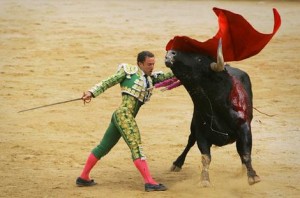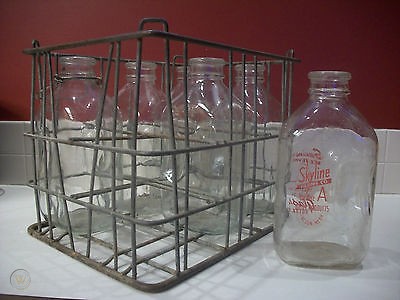Walk Like A Matador
Walk Like A Matador
 Do you know the name of the first grocery store in Peoria that had scanners at checkout lanes, instead of cash registers where everything had to be rung up one at a time by hand? I know the name of the store because I worked there when I was in high school. The store was Randall’s Foods and it was located in the Westlake Shopping Center, across the street from Northwoods’ Mall.
Do you know the name of the first grocery store in Peoria that had scanners at checkout lanes, instead of cash registers where everything had to be rung up one at a time by hand? I know the name of the store because I worked there when I was in high school. The store was Randall’s Foods and it was located in the Westlake Shopping Center, across the street from Northwoods’ Mall.
I started working at Randall’s during the fall of 1974 when I was a senior in high school. I was 17 years old and I got a job there, after one of my classmates encouraged me to apply. He had started working at the store when it opened earlier in the year. He told me that he like working there and was happy with the pay because it was more than what other stores in the area were paying.
A few weeks after I was hired at Randall’s, I attended a relative’s wedding with my parents. While I was at the wedding reception, I saw my uncle Harry LaHood, and he asked me how everything was going. I told him I had recently started working at Randall’s and my primary job there was to “sack groceries” for customers. Back then the grocery stores used large heavy-duty paper sacks for groceries. Now the stores use the thin plastic bags with handles. What we called “sacking groceries” is now called “bagging groceries.”
My job at Randall’s consisted of sacking groceries, loading the sacks into carts, and then delivering the loaded carts to a pickup area located right outside one of the doorways of the store. Customers would then drive their cars over to the pickup area and a store employee would load the groceries into the customer’s car, without the customer having to get out of the car. When I wasn’t sacking groceries, I was either working in the pickup area loading cars, or I was helping out with stocking shelves.
After I finished explaining my job to my uncle, he said, “Would you like to learn a secret that will make you one of the best workers in the entire store?” After I told him yes, he grabbed a paper napkin from a nearby table, pulled a pen out of his pocket, and started drawing on the napkin. He drew a couple of checkout counters, a wall, and a doorway. At the end of one of the checkout counters, he placed an “A” and then he began his explanation:
Imagine you’re standing at Point-A sacking groceries for a customer. After you’re done loading the sacks into a cart, you decide you’re going to take the cart out to the pickup area of the store. (He then placed a “B” where the pickup area was.)
You have made a decision to walk from Point-A to Point-B. Now the typical worker would walk at a regular pace from Point-A to Point-B, but you’re not a “typical” worker. Instead of moving at an average pace, you walk as fast as you can from Point-A to Point-B. Don’t run. Just walk as fast as you can. (He then drew a line from Point-A to Point-B with an arrow at the end of the line pointing to the B. When he drew the line, he didn’t just casually draw it; instead, he quickly drew the line as though he was in a hurry for his pen to get from Point-A to Point-B.)
When you get to Point-B, you don’t have to work any faster than you ordinarily would. Just load the groceries into the customer’s car as you normally would. After you’re done loading the groceries, let’s say you turn around and see that there are no customers in any of the checkout lanes. You decide to check to make sure that each of the counters has a sufficient supply of sacks so no one runs out. (He then placed a “C” near the area of the store where the extra sacks were stored.)
You have now made a decision to walk from Point-B to Point-C. Now again, the typical worker would walk at a regular pace from Point-B to Point-C, but you’re not the “typical” worker. Don’t run, but you need to walk as fast as you can from Point-B to Point-C. (He then quickly drew another line with an arrow from Point-B to Point-C.)
When you get to Point–C, you grab a pile of sacks and you again walk as fast as you can to the first counter to refill the supply of sacks. You then do the same with each counter you go to. After you’re done refilling the sacks at the counters, let’s say you make a decision to go help out with stocking shelves. Decide where you’re going to end up and then walk as fast as you can to your new destination point. After that, anytime you decide to move from one point to another, you have to walk as fast as you can. Each time you get to where you’re going, you should be diligent in getting your work done, but you don’t have to rush. You just need to walk fast whenever you’re moving from one point to another.
Any time you run out of work to do, you should do one of three things: (1) ask the manager what he needs for you to do, (2) look around and find some work that needs to be done and then do it, or (3) help one of your co-workers with his work. Don’t ever stand around doing nothing or passing the time by visiting with another employee. You’re being paid to work, so you should always be moving.
By doing what I am telling you to do — walk fast every time you move from one point to another and keep yourself busy — you will be seen by the management of the store as being a valued employee who hustles to get things done. When they see you almost running everywhere you go, while all the other employees take their time to get from one place to another, they’ll think, “Wow, that Harry Williams really works hard. We need to make sure to treat him well, so we don’t lose him to the competition.”
The next time I worked I did exactly what my uncle told me to do and continued to follow his advice every time I worked. Six weeks after I started doing what he told me to do, the general manager of the store approached me and asked me to come to his office. When we got to his office, he closed the door and told me that I was being promoted. He gave me a $1 an hour raise and told me my new job was stocking shelves. He then proceeded to tell me how all of the department managers — dairy, produce, meat, and grocery — noticed how hard I worked.
Several years after Uncle Harry shared his secret with me, I learned that when a young man is taught how to be a Matador (bullfighter), he is told that he must always “walk like a Matador.” He is told that whenever he is in the ring with a bull, his body should be completely upright and that he should walk fast with an air of confidence, boldness, and courage.
Last summer, I stopped at Cedar’s Bakery in Peoria to pick up some groceries for Georgette. On my way out of the store, I saw a car pull up to the curb and stop. Out jumped Uncle Harry, who at that time was 76 years old. He quickly walked around the front of his car and when he got to the steps in front of the store, he leapt up the stairs, two at a time. When he got to the top of the stairs, he saw me standing there and stopped to talk to me. We visited for a short time before he went into the store. As I was walking to my car I thought, “He still walks fast.” Later, when I was thinking about what had happened, the thought occurred to me: “He not only still walks fast, he walks like a Matador.”
Next time you’re watching a championship competition, notice how the superstar athletes walk. They all walk like Matadors — before, during, and after a game. My spiritual advisor and mentor, Fr. John Hardon, walked like a Matador, all the way up until the last year of his life (he died at the age of 84). I would bet that our Lord and all the saints who followed in His footsteps, including the Blessed Virgin Mary, St. Joseph, St. Peter, St. Paul, St. Joan of Arc, and St. Philomena, all walked like Matadors — upright, confident, bold, courageous, and fast.
All champions walk like Matadors. They’re on a mission and they don’t have any time to waste. Do you want your son to become a champion in the workplace? He doesn’t need to start out confident, bold or courageous, but he does need to walk fast, avoid being idle, and refrain from visiting with others while he’s “on the clock.” Once he develops the habit of walking fast and staying busy, he’ll start to receive recognition and respect from his fellow employees and his boss, which will, in turn, help him to become confident, bold and courageous.
You now know the first of the three fundamentals every boy needs to learn before he can expect to excel as an employee. Next week I’ll share with you the second fundamental — a fundamental that the greatest football coach of all time demanded that all of his players learn and practice.




2 Comments
[…] the managers that he has ambition and is serious about finding a job. I also explained to him my “Walk Like A Matador” concept, which I wrote about a few years […]
[…] week, when I learned that my 85-year-old uncle, Harry LaHood, Jr., was not doing well, I thought about the breakdown of generations and the differences among […]